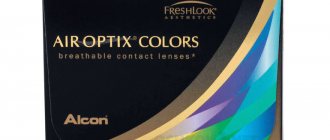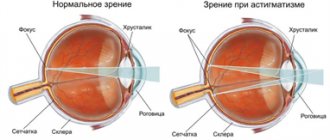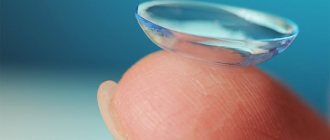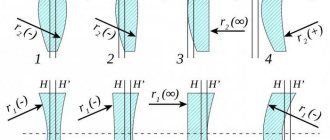Contact lenses are used by many people around the world. They allow you to temporarily improve vision while remaining virtually invisible to others. A little earlier they were made of glass, and no one wondered about the possibility of sleeping in these products. But modern technologies have made it possible to greatly expand the range of lenses. There are soft and hard models, elastic and silicone, and there are other options for these correctors.
Lenses can be used not only to improve vision, but also to change your image. They allow you to change the color of the iris, changing the appearance of the person using them. These corrective products are produced by many companies; the number of brands produced is huge. And each model has its own instructions for use. Please read these instructions carefully after purchasing this product. If you strictly follow the instructions for wearing these optical products, you can wear them for a long time without causing harm to your eyes.
Is it possible to sleep in lenses?
The answer to this question is ambiguous. The opinions of ophthalmologists and manufacturers differ greatly. The former not only have a negative attitude towards sleeping in these optical products, but also do not recommend wearing them for more than 10 hours at a time. They believe that lenses should be disinfected in a special solution as often as possible in order to reduce the amount of bacteria that accumulate on them and reduce the risk of infectious diseases.
The latter, in order to emphasize the quality of their product, place on the packaging information about the possibility of round-the-clock use of models of this brand, including during sleep. The manufacturer puts the high quality of the material used, for example, silicone, at the forefront. And although the product is well ventilated, allowing oxygen to pass through to the eyes, allowing them to breathe, with prolonged wear it is quite possible to develop an allergic reaction.
It is especially prohibited to sleep in disposable lenses, which are intended for one-day wear. You can wear them all day and then throw them away. Although they can also have a short nap during the day, not exceeding an hour and a half. However, after waking up, a person may feel discomfort, redness, and dryness in the eye area. A few moisturizing drops that should be dripped into the eyes after removing the products will help relieve discomfort.
People often use such daily lenses on the road, where it is not possible to remove the products before going to bed and then put them on again the next day. In this case, the products are simply removed in the evening and disposed of, and a spare pair is put on in the morning.
What are orthokeratology lenses?
Orthokeratology optical products - rigid, gas-permeable, night lenses. They are put on before going to bed, during which they deform the shape of the cornea or eyeball, correcting any visual pathology that your doctor has diagnosed. You spend the whole day without correction products, during this time your eyes acquire their original shape, and at night you put on night lenses again.
Since children do not like to wear glasses and it is not always possible to accustom them to daily contact lenses, orthokeratology becomes a salvation. It helps stop the progression of myopia, which is increasingly encountered by people in childhood.
This method of treatment is prescribed only by a doctor, all of whose instructions must be followed to avoid complications. Orthokeratology lenses are selected and manufactured individually. They have contraindications and specific features of use, so independent selection can be dangerous for vision.
Now you know which lenses you can sleep in and which you can’t, what the consequences of improper use can be and how to avoid them. In our online store you will find lenses with different wearing modes.
What lenses can you leave on at night?
Vision correctors, which according to manufacturers can be left on at night, attract many consumers. It is very convenient to go straight to bed after a hard or eventful day, rather than having to remove your lenses and place them in a disinfectant solution.
However, ophthalmologists insist on the need to remove all brands of vision correctors before going to bed, regardless of their price and labels on the packaging. To solve this issue for yourself, you need to carefully familiarize yourself with the properties of the material from which the optical products used are made.
Hydrogel
It was from hydrogel that the first soft contact lenses were made. Optical products made from this material are soft and very comfortable, do not cause allergic reactions and do not dry out the cornea, as they have a high moisture content. However, they do not allow oxygen to pass through and do not allow the cornea they cover to breathe, so it may experience oxygen starvation.
Silicone hydrogel
Two materials are used to make silicone hydrogel correctors. Therefore, they have all the positive qualities of hydrogel lenses, but, thanks to silicone, they are free of their disadvantages and allow oxygen to pass through well. It is believed that you can sleep in them.
But this material has its downside. It may cause allergies. Therefore, contact lenses of this type should be purchased only after consultation with an ophthalmologist. Silicone hydrogel products also have other negative features. Contact products made from this material are somewhat stiffer than hydrogel ones, and by the end of the day some deposits may form under them. Currently, searches are underway for other materials that would improve the parameters of contact lenses.
Lens material
CLs come in soft and hard ones, made of hydrogel and with the addition of silicone. The active materials affect the properties of the optics, the passage of oxygen to the cornea, the maintenance of hydration and the duration of wear.
Polymethyl methacrylate
This substance is used in the production of rigid products, the maximum time of use per day is up to 12 hours. It has poor air permeability, so if the instructions and operating rules are not followed, it can lead to oxygen starvation (hypoxia) of the cornea. It can also stick to the mucous membrane of the eye.
Hydrogel
Used to create soft contact lenses primarily for daytime use. Through the hydrogel, oxygen flows well to the cornea, oxygen starvation is prevented.
CLs made from this material are worn for up to 12 hours. Daytime and nighttime sleep is unacceptable in them.
Hydrogel with added silicone
An advanced formula used to create daily, extended and continuous wear lenses. Depending on the instructions on the package, short-term daytime sleep of up to 2 hours and night sleep are allowed.
Daily wear lenses must be removed at night. Long-acting - can sometimes be left on for several days, including 1-2 nights.
Easy-to-use long-term wearing contact lenses - depending on the instructions, you can wear them continuously for up to 2 weeks, a month, or 3 months. Sleeping in them is allowed. However, to prevent hypoxia, it is recommended to periodically remove it to rest the eyes and process products.
Rigid gas permeable lenses
Made from hard polymer with added silicone. They provide good air access to the cornea and are used during the daytime.
We recommend reading: Gas-permeable hard lenses
Orthokeratology lenses
This is a special type of nighttime lens used to correct myopia. They prevent oxygen starvation of the mucous membrane and correct the thickness and shape of the cornea.
Feature of use: put on at night, then take off in the morning. Repeated use is possible after vision deterioration occurs.
We recommend reading: Orthokeratology lenses
What happens if you don't remove your lenses at night?
Everyone experiences sleeping in contact lenses differently. Some people do not feel any discomfort at all in the morning, and their visual organs remain in perfect order. Others, on the contrary, painfully endure such a dream, after which they may completely abandon such vision correctors and give preference to glasses.
A person’s condition after sleeping in corrective products can be influenced by:
- protein concentration in tears;
- the level of sensitivity of the body itself;
- corrector material and its quality.
Therefore, you should not sleep in vision-correcting products unless absolutely necessary. After all, loss of vision is too high a price to pay for such experiments with your health.
The story of 23-year-old Taiwanese student Lian Kao, which was told on the Internet, is very instructive in this regard. For 6 months the girl slept in contact lenses. The products were not treated with disinfectants and over time, single-celled bacteria settled on them and began to eat Lian’s eyeballs. As a result, the girl lost her sight.
This disease is called “acanthamoeba keratitis” and is asymptomatic. When it can be diagnosed, vision is often already lost forever. Therefore, you should not be lazy, but should spend a few minutes removing and putting on lenses to avoid such unpleasant consequences for the visual organs.
The Horrible Story of Lian Kao
Lian Kao (23, Taiwan) paid dearly for keeping her contact lenses in for six months. During her carelessness, single-celled Acanthamoeba bacteria, which are common in almost all countries of the world, accumulated on the inner surface. It took them six months to… eat the girl’s eyeballs !
A shot of poor Lian Kao's eyeball
Personally, I have a hard time believing that a person is generally capable of wearing lenses for so long without removing them, but this information has been published in many publications. Therefore you have to believe. I don’t know, maybe Lian had never heard about the wearing rules or was simply lazy, but as a result, the bacteria had an irreparable impact on the girl’s health. They literally ate her eyes and the student went blind. This disease is called acanthamoeba keratitis - it is different in that it can develop for several years and the patient learns about the disease when nothing can be corrected.
Video – Lenses devoured a girl’s eyes
This is such an unpleasant and sad story. Well, let's move on.
If you forgot to remove your lenses by accident
But sometimes a person can fall asleep in correctors by accident, for example, due to extreme fatigue after a hard day. What could this mean for him? When creating the lenses, the developers understood that this could very well happen. Therefore, simple rules have been developed for this case, by following which you can minimize the consequences of a night spent in contact correctors.
If, after sleeping, there is redness in the lenses the next morning, dry mucous membranes and itching are felt, and there is a feeling that the corrective products are simply stuck to the cornea, you need to take the following steps:
- Apply a moisturizing solution that will allow you to remove the lenses after a short period of time. Under no circumstances should correctors be pulled off the cornea while it is dry, as this can lead to injury.
- Give your eyes a rest after removing your contact lenses and replace them with glasses for at least a day. It is possible that after sleeping in correctors, your vision will deteriorate somewhat, but this is usually a temporary phenomenon.
- If possible, see an ophthalmologist and conduct a full eye examination.
If you buy comfort class models, which are more expensive in price, then in principle you can sleep in them. But, although they allow the organs of vision to breathe, they also cannot sleep for many days in a row. After sleeping in lenses, you need to take a break from wearing them and give your eyes a rest.
What to do if complications develop?
If the patient decides that he can sleep in the lenses, but he has unpleasant sensations at the moment when he fell asleep or woke up, then he needs to consult an ophthalmologist. A similar tactic should be chosen if dryness or redness of the mucous membrane of the eye appears. Only a doctor can correctly and accurately diagnose and prescribe the most appropriate treatment.
If problems arise, you should consult a doctor
Prevention is much cheaper and sometimes more effective than subsequent treatment. In this regard, everyone who wears lenses needs to familiarize themselves with the rules for their use and strictly follow them. This approach allows you to prevent any unpleasant effects from the use of lens products. Detailed recommendations on the use of lenses can be obtained from an ophthalmologist or in optical salons.
If you sleep in lenses for a whole month
Even one night in contact lenses can bring trouble, and a month in general threatens with a whole range of infectious and non-infectious diseases. The simplest and most common of them is conjunctivitis, which irritates the mucous membrane and subsequently leads to infections, viral or bacterial. After treatment, the person’s desire to sleep in corrective products completely disappears, and he begins to treat eye hygiene more responsibly.
Doctors of medical sciences, representatives of the American Academy of Ophthalmology, clearly explain to patients why spending the night in lenses is harmful. The eye needs oxygen from the external environment. If his cornea is closed during sleep, the amount of oxygen reaching him is significantly reduced. Lack of oxygen can lead to corneal swelling and further erosion.
Also, the human visual organs are not able to effectively resist bacteria, and contact lenses create an environment under their surface that is favorable for their reproduction.
If the lenses are not removed for a long time, for example, a month, then a colony of bacteria can cause significant damage to the eyes. In addition, allergic reactions cannot be ruled out.
Features of using contact lenses
Contact vision correction devices are an optimal alternative to glasses for a number of reasons. One of the key points is that such optical products do not hinder movement at all and allow you to freely play sports and lead an active life.
In addition, among the undoubted advantages, experienced users note that they do not fog up when temperature changes, provide a wide viewing angle and the highest image clarity. And with age-related changes in vision and the occurrence of presbyopia or astigmatism, multifocal lenses with different optical zones allow you to forget about using several pairs of glasses.
Manufacturers of modern contact optics care about their customers, which is why there are many different types of lenses.
Most modern contact products have excellent moisture content, breathability and are absolutely not noticeable when in use.
They differ in material, design, possible operation time and wearing mode. Ophthalmologists recommend choosing optical products not only based on the individual parameters of the visual system, but also taking into account your lifestyle.
So, if a person has an irregular work schedule, often travels or is on trips, he needs ophthalmic products with a special wearing regime.
What do you need to know about such lenses?
Daily wear lenses provide maximum comfort and relieve the user from the daily manipulations associated with their care.
This product recently appeared on the domestic optics market and immediately gained high trust among contact doctors and their patients. Doctors note the high hygiene of the lens: minimal contact of the lenses with hands, no contact with solutions and, as a result, the absence of allergic reactions. In addition, users do not have to spend time caring for the lenses: at the end of the day they simply need to throw them away and put on a new pair in the morning.
Long-term continuous wear lenses are available. Read more about them here.
One-day colored lenses will be a real boon for children, teenagers, athletes, public people who lead an active lifestyle, go on the road or, due to circumstances, cannot constantly care for traditional lenses. After all, care requires responsibility and even pedantry. Such lenses will be useful for anyone who does not want to give up glasses, but is forced to use lenses from time to time. They will not have to calculate the date of the next lens replacement. One-time use of the product will protect your eyes from unwanted infections and irritations.
According to ophthalmologists, disposable lenses will be the optimal solution in the following cases:
- increased eye sensitivity;
- the patient's tendency to allergies;
- user needs for maximum comfort and convenience;
- active sports;
- lack of time or desire to carefully care for routine replacement lenses.










